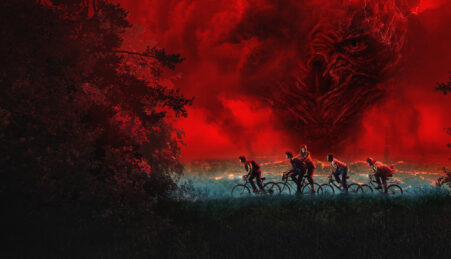
Humanity Hallows Issue 6 Out Now
Pick up your copy on campus or read online
By Grace Atkinson
What I’ve always found fascinating about Joy Division is the environment that the band stemmed from: four lads formed on the depressed streets of Manchester, a city that was facing major social and economic depression. The band began as a punk group, a resistance against Thatcher’s rising consumer fascism, and an answer to the isolation the working class were experiencing. What complicates this is the merchandise that surrounded Joy Division and New Order, their visual identity a branding that came hand-in-hand with their success. True Faith is an eclectic collection of original artifacts, record sleeves, posters, intimate footage, fashion collections, personal items, and responsive art that narrates the relationship between music and design, and the consumer culture from which Joy Division and New Order evolved.
The exhibit begins with Peter Saville’s original Joy Division and New Order record collection, the covers of which he designed. It’s the perfect opening, as Saville’s work is as iconic as the music, the cover for Unknown Pleasures still worn on t-shirts today. The band’s lack of interviews and other typical forms of press meant that the their visual presence was crucial to their promotion, and when Joy Division released the track Atmosphere under the label Sordide, Curtis prided the record not just as a piece of music but as an object in its own right, it’s cover design and book-like format transcending the record into a work of art.
I noticed an amazing diligence to portraying the story behind each cover. New Order’s Power, Corruption and Lies, is matched with the original postcard that Saville picked up from the National Gallery’s gift shop, which is then matched with the original painting: Basket of Roses by Henri-Fantin Lotour. The painting hangs inside a protective glass box beside the postcard, and the viewer is invited to pretend to be Saville, encountering the painting for the very first time.
These articles are punctured by abstract pieces of art, responses to both bands and their almost mythological status. The neon trees of Martin Boyce’s Our Love is Like the Flowers, the Rain, the Sea and the Hours are dotted among the collection, providing an ambient fluorescent lighting in a gloomily lit space. The landscape of a run-down urban park, incandescent with a sort of unknown magic, is the perfect setting to Joy Division’s rise out from Manchester’s rubble, a glow that was slowly lighting the depressed streets of the era.
Matthew Brannon, who often plays with the 20th century consumer-culture in his work, places Johnson’s Baby Oil and Joy Division’s Love Will Tear Us Apart at a juxtaposition in his print Understandable Feelings. The distinctive slogan ‘No More Tears’ undercuts the sincere vulnerability of the track with trite branding, the words ‘Hey now. Hush. Everything is going to be ok. You’re a grown man’ read as ironic in light of Curtis’ tragic end. It’s true that the authenticity of emotion sells very well when packaged correctly.
A film by Mark Leckey, named Dream English Kid 1964- 1999 AD, showed a disturbing time-line of the world in which Joy Division originally grew from, and later lived in. Images of space travel, motorway underpasses, electricity shops, products and packaging, computer screens and digital sound waves (‘I feel it closing in… day in, day out’) combine in a nightmarish sequence. One shot of a single-windowed room, just fitting a mattress and sleeping bag, echoed stories of Ian Curtis’ first epileptic fit, where he wrapped himself in a sleeping bag, growling and lashing at other band members. Back when Curtis was diagnosed with epilepsy, the lack of understanding around the condition made it terrifying and alien. Leckey’s high-tension soundtrack and flashing images hint at the hysteria around it.
Like so many young artists, tragically taken by mental illness, drug abuse, or fame itself, there is a sort of legendary status that Curtis fell under after his suicide. As I surveyed the collection of New Order memorabilia and live footage, I couldn’t help but feel Ian Curtis’ epic presence lingering over it all. The last display showed an object of pure, authentic sentimentality: the lyrics of Love Will Tear Us Apart, hand-written by Curtis. It’s true that both bands came from an honest, historic turmoil, their relevance and ability to reach the people unshakable, and, though their visual status nods to the vacuous world of consumption, I left Manchester Art Gallery finding it impossible to question the earnest beauty of Curtis’ lyricism, and the powerful way in which both Joy Division and New Order reflect the world around them.
True Faith will show at Manchester Art Gallery until Sunday 3rd September






Leave a reply